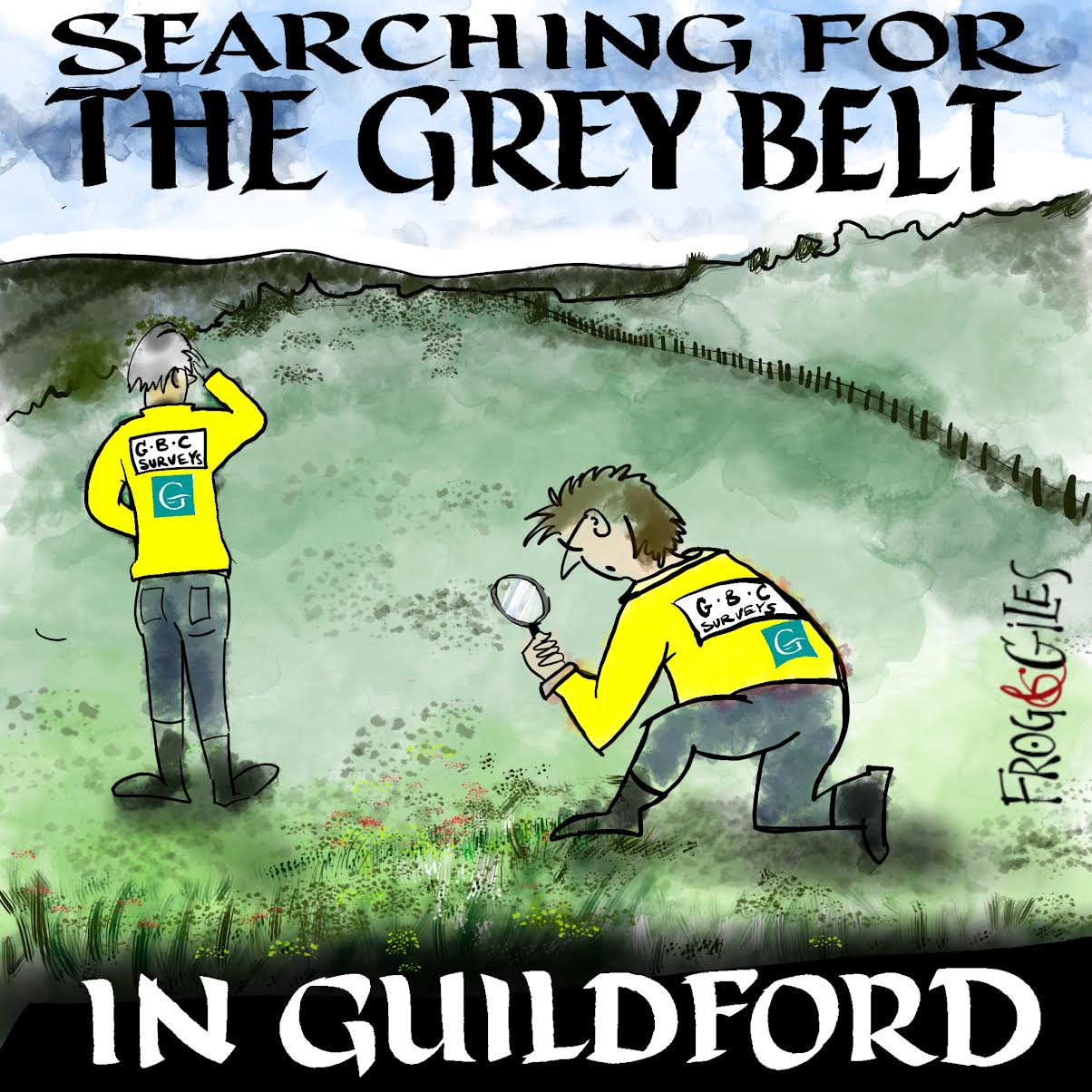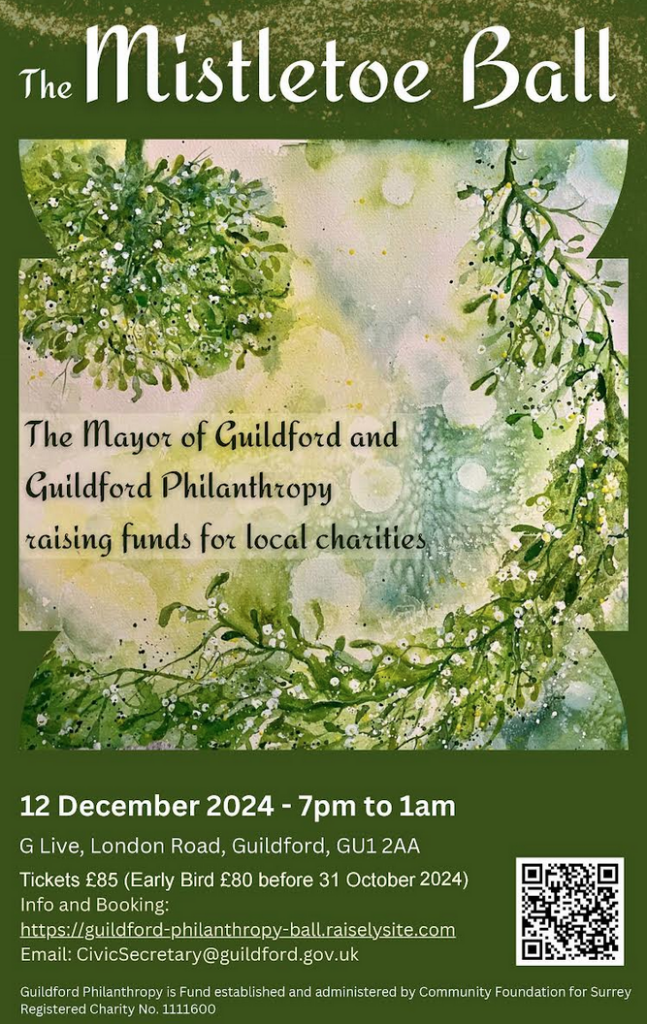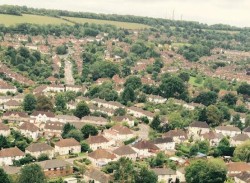 Abraham Lincoln
If given the truth, the people can be depended upon to meet any national crisis...
Abraham Lincoln
If given the truth, the people can be depended upon to meet any national crisis...
 Guildford news...
for Guildford people, brought to you by Guildford reporters - Guildford's own news service
Guildford news...
for Guildford people, brought to you by Guildford reporters - Guildford's own news service
Letter: Guildford Needs More Houses – Green Belt Should Not Be Sacrosanct
Published on: 22 Apr, 2016
Updated on: 22 Apr, 2016
Hon Alderman and former Mayor
Councillor Rooth is, in my opinion, quite right. We are desperately short of housing, not just welfare housing but housing for skilled workers in schools, hospitals and, even more so, for the high tech enterprises which are the only economic future we have.
New companies are no longer coming to Guildford as housing costs are too high. Is no one worried about this?
Why is 89 per cent of green belt so sacrosanct that none can be provided for desperately needed homes? Are these homes not more important than views of homes for birds and bees?
 The figure of 1.6 per cent is only around 300 acres and would not affect designated Areas of Outstanding Natural Beauty [AONBs] .
The figure of 1.6 per cent is only around 300 acres and would not affect designated Areas of Outstanding Natural Beauty [AONBs] .
The 40 per cent affordable homes is an admirable target but only feasible physically if we release some small areas of green belt land, and only financially feasible if we ensure there are financial community benefits from development of them.
I agree with those who say that the definition of 80 per cent of a market rental is not likely to be low enough. It all depends on what housing costs are – and how much one has to pay for land – which currently accounts for 2/3rds of housing costs.
This part of the problem needs attention, as does the method of how to ensure the housing remains in the affordable category.
There should be more scope for town centre housing in place of retail for which the current plan still allocates 48,000 sq m – around 40 per cent of current retail development.
This is absurdly high. We do not need yet more retail, investors would be unwise to put funds into it and many local firms would close in face of such a massive expansion.
The problem is that most of this land is owned privately and the owners have paid far too much for it. While there is a huge demand for town centre housing by the asset rich elderly, land prices are high and affordable housing would not be easy.
Responses to Letter: Guildford Needs More Houses – Green Belt Should Not Be Sacrosanct
Leave a Comment Cancel replyPlease see our comments policy. All comments are moderated and may take time to appear. Full names, or at least initial and surname, must be given.

"Found any?" - "Nope, it all looks green to me!" (See Opinion: The Future is Congested, the Future is Grey)




Recent Articles
- Postcode Lottery Police Funding – It ‘Cannot Be Fair’ Says Police Commissioner
- Heartbreak for City Again as Two Extra-time Goals Snatch Victory
- Letter: All Three Major National Parties Are Relaxed About Green Belt Giveaways
- Updated: Ash Level Crossing Decision ‘Was Made Without Approval of Surrey Highways’
- Sara Sharif Trial Latest – ‘Fear and Violence Reigned’ in Sara’s Home
- Dragon Interview: Julia McShane leader of GBC’s Lib Dems
- Letter: Ash Bridge – We Need Accountability and Competence
- Letter: SCC’s Final Decision is Unlikely to Put an End to the Issue of the London Road Layout
- Only Cabinet Members Will Speak at SCC’s Meeting to Decide on London Road Scheme
- Highways Bulletin for November 25


Recent Comments
- Jane Hughes on Sara Sharif Trial Latest – ‘Fear and Violence Reigned’ in Sara’s Home
- John Ferns on Ash Level Crossing Will Close Before Opening of New Road Bridge
- Olly Azad on Ash Level Crossing Will Close Before Opening of New Road Bridge
- Roshan Bailey on Student Named Land Based and Horticulture Learner of the Year
- Frank Emery on Ash Level Crossing Will Close Before Opening of New Road Bridge
- Paul Robinson on Letter: The Active Travel Proposal Is the Safest Option for London Road
Search in Site
Media Gallery
Dragon Interview: Local Artist Leaves Her Mark At One of England’s Most Historic Buildings
January 21, 2023 / No Comment / Read MoreDragon Interview: Lib Dem Planning Chair: ‘Current Policy Doesn’t Work for Local People’
January 19, 2023 / No Comment / Read MoreA3 Tunnel in Guildford ‘Necessary’ for New Homes, Says Guildford’s MP
January 10, 2023 / No Comment / Read More‘Madness’ for London Road Scheme to Go Ahead Against ‘Huge Opposition’, Says SCC Leader
January 6, 2023 / No Comment / Read MoreCouncillor’s Son Starts Campaign for More Consultation on North Street Plan
December 30, 2022 / No Comment / Read MoreCounty Council Climbs Down Over London Road Works – Further ‘Engagement’ Period Announced
December 14, 2022 / No Comment / Read MoreDragon Interview: GBC Reaction to the Government’s Expected Decision to Relax Housing Targets
December 7, 2022 / No Comment / Read MoreHow Can Our Town Centre Businesses Recover? Watch the Shop Front Debate
May 18, 2020 / No Comment / Read More







Stuart Barnes
April 22, 2016 at 9:18 am
So after this 1.6 per cent has been built on what about the next push on the green belt for the next lot of migrants?
Remember that between 300,000 and 500,000 are coming here each year and David Cameron’s devious propaganda leaflets indirectly confirm that. I foresee that in a couple of years after that 1.6 per cent disappears under concrete another slice will be called for, and so on, until there is nothing left.
Our only hope is to control our borders and we cannot do that until we get out of the corrupt EU. I hope everyone remembers that remember that on 23/6.
As an aside, what a cheek that the worst US President in modern times has the gall to tell us how to vote.
John Perkins
April 24, 2016 at 2:57 pm
I don’t think Stuart Barnes should get too worked up about President Obama. People see him for what he is: a man who knows nothing of this country and cares even less.
If 200 years ago people had accepted the arguments advanced by him then the USA would have remained part of the British Empire.
George Dokimakis
April 22, 2016 at 10:11 am
Excellent article with many valid points.
The only thing I would challenge is the retail space. I assume that the retail space includes office space.
We do not need more shops but we definitely need more places for people to work, otherwise Guildford will become a commuter and satellite town to London.
Ramsey Nagaty
April 22, 2016 at 3:58 pm
Gordon Bridger is espousing incorrect information. The revised Local Plan does include building on a designated Area of Outstanding Natural Beauty and and Area of Great Landscape Value at Blackwell Farm despite Cllr Matt Furniss’ previous statement that these lands, so designated, would not be built on.
Karen Stevens
April 22, 2016 at 7:22 pm
The Blackwell Farm site does indeed include some land that is designated AGLV at the southern end of the site – this AGLV is also 18th century parkland.
I consider that the proposed access road to the site constitutes development in the AONB. The revised Local Plan talks of “enhancing” the Down Place road – a very attractive tree-tunnelled, single track lane that forms a lovely feature in the AONB.
I think “enhancing” is a euphemism for widening the track and tearing down the 18th century trees, although the Plan is rather vague about this and also talks of running the new access road alongside the Down Place lane. In either case, this new access road would constitutes a development in the AONB, in historic parkland and in, or adjacent to, ancient woodland.
Finally, the entire site is damaging the setting of the AONB as it can be viewed from various points along the ridge, including The Mount.
At the East Guildford Residents Association (EGRA) hustings in March 2014, Matt Furniss did state:
“Protected countryside designated as AONB (Area of Outstanding Natural Beauty), AGLV (Area of Great Landscape Value) and SSSI (Sites of Special Scientific Interest), will not be considered for development by a Conservative borough council”
This was covered in The Dragon.
I believe the green belt should be sacrosanct. It was created for a purpose – to stop urban sprawl. What is the point of the green belt if you ignore it when it begins to do its job?
Jules Cranwell
April 22, 2016 at 4:54 pm
Mr. Bridger would do well to reflect on the fact that those bees he dismisses as irrelevant keep this planet alive.
Without the bees, and land for bee-keepers, we would have no food.
Of course, this probably will not matter when we no longer have any green fields left, as we’ll be importing all our food.
Next, those countries we import from will follow suit. What then?
Adrian Atkinson
April 22, 2016 at 6:44 pm
Mr Bridger does talk sense in one respect. Increasing retail, is a dead policy let alone one for 2031. The retail sector will not recover. Like Monty Python’s dead parrot, retail wouldn’t “voom” if you put four million volts through it! Retail’s bleedin’ demised.
Much of the town centre land currently earmarked for more shops should be turned over to housing. This could:
help create a vibrant nightlife economy which will create more growth than retail;
reduce reliance on cars, better for pollution and better for our strained infrastructure
reduce the number of trucks thereby further reducing congestion and pollution;
allow smaller affordable units to be located closer to places of work for key workers.
Retail is almost dead. Perhaps dead is a strong word, but the sector is trending towards invisible. We should not be planning an increase in retail space at the expense of homes for Guildford. There is no evidence it is needed. We are supposed to be planning for the future, not the past. We will need less space for shops than we need now, lots more shops is a bad idea.
I have been working around retails for the last 25 years. This is not a new trend and is one that is not going away. It is in fact accelerating. The bricks and mortar retail sector is in steady decline. The BRC [British Retail Consortium] predicts 900,000 jobs will be lost in the sector by 2025.
This article about Kingston sums up what we are sleep walking into with this flawed Guildford plan:
I will be emailing this article to every councillor. To ignore it would question their understanding. Guildford deserves a plan grounded in reality not some sort of wish list of 3rd parties.
However, Mr Bridger is off the mark in the rest of his letter.
Land values are not 2/3rd of the cost of a house.
Berkeley Homes Chairman is the second highest paid UK Company Exec at a cool £22m. Their bonus incentive pot for its employees is around £1bn if they hit targets. We are essentially giving away our green land to line the pockets of the fat cats with absolutely no guarantee of delivering the housing we need for our current UK population. To hit their profit targets they will take up the plan’s invitation to pull out of all affordable housing provision they can (affordable is defined as 80% of market rate, ie not affordable) based on “viability” grounds.
Also, what does Mr Bridger think bees do? Buzz around, doing naff all all day, admiring their natural environment? “Pollinators are a critical link in our food system. More than 85 per cent of earth’s plant species – many of which compose some of the most nutritional parts of our diet – require pollinators to exist. Yet we continue to see alarming declines in bee numbers,”
“A world without honeybees would also mean a world without fruits, vegetables, nuts, and seeds. Nearly one-third of the world’s crops are dependent on honeybees for pollination, but over the last decade the black-and-yellow insects have been dying at unprecedented rates” Quoted from What Our World Would Look Like Without Honeybees, Dina Spector, Business Insider 2013.
Let’s look at it another way, 2/3rds of the proposed housing in the revised Local Plan is destined for the green belt. To accuse people of campaigning that this level of green belt development means they are against any green belt development is a gross misrepresentation.
Harry Eve
April 27, 2016 at 9:17 am
I am surprised that Mr Bridger thinks that the area of green belt that our council plans to throw away for the benefit of developers is “only around 300 acres”.
I would be interested to hear from Mr Bridger how he arrived at that figure as I believe the reality is much higher.
Ben Paton
April 27, 2016 at 6:55 pm
Where indeed does Mr Bridger get his figure of 300 acres as the total amount of Green Belt sacrificed to developers in the draft local plan? Three Farms Meadows in Ockham, also known as land at the former Wisley airfield ALONE is a bit under 300acres in size. So Mr Bridger’s figure is miles out.